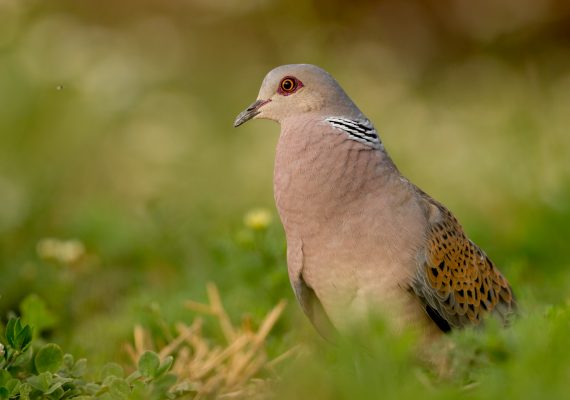Trends of common birds in Europe, 2021 update
December 6, 2021
This report presents updated population trends and indices of 170 common European bird species for the time period 1980–2019 that have been produced by the Pan-European Common Bird Monitoring Scheme (PECBMS) in 2021. The species trends presented are for a long time period (from 1980 onwards until 2019) and for the last ten years (2010–2019).

Croatia and Flanders joined PECBMS this year, contributing and improving the supranational species index of the Turtle Dove, Streptopelia turtur. Photo by Ĺubomír Ondráško (www.luboondrasko.sk).
Download European species indices and trends till 2019 (Data Provision and Co-Authorship Policies applies).
Data
In 2021, a reliable European index was produced on 170 species, which is the same number of species as in the last update in 2020.
This time, we added new data to our dataset: new country Croatia delivered their data for 2015–2019 and Belgium region Flanders contributed with scheme data for period 2007–2019 (which means that since this update, Belgium as a country is completely covered by three regional schemes: Brussels, Wallonia and Flanders). The list of 29 countries provided their data for this update: Austria, Belgium, Bulgaria, Croatia, Cyprus, Czech Republic, Denmark, Estonia, Finland, France, Germany, Greece, Hungary, Italy, Latvia, Lithuania, Luxembourg, Netherlands, Norway, Poland, Portugal, Republic of Ireland, Romania, Slovenia, Slovakia, Spain, Sweden, Switzerland, United Kingdom.
The countries provided the data for different time periods, see Methods, chapter 2.3. Types of supranational results that PECBMS produces or check the ´List of countries´ at the individual species graphs.
Methods
A detailed description of computation steps and methods is available in the special section Methods, in chapter 1. National species indices and trends and chapter 2. Supranational species indices and trends.
Species habitat classification for main habitat types (farmland, forest, and other) is described in Methods, chapter 3, Box Species selection, and classification.
Results
We present long-term and ten-year trends and slopes in the table. The Long-term Slope is calculated over the period 1980–2019 but the starting years of this long time period vary from 1980 to 1998 (as specified in the Species notes below the table of trends). In parallel, the Long-term Trend represents a change (in %) in an index value between the first and the last year of this long time period. The Ten-year Slope is calculated over the period of the last ten years, i.e. 2010–2019. Similarly, Ten-year Trend represents a change (in %) in an index value between the first and the last year of the period of the last ten years.
Updated European species indices, long-term and ten-year trends and slopes, and species habitat classification are summarized in the table. For explanations to the table see also the pop-up windows which appear after clicking on the notes shown in selected species names as an upper index.
To generate a graph for the selected species, tick the checkbox at the left side of the species name and click the Show button above the table to confirm and proceed with your selection. You can draw graphs for several selected species in separate graphs or at once in one graph – select the option in All data in one graph above the table. If you wish to Show confidential limits, you may choose this option only in the case that you selected only one species to be shown in a graph. You can also quickly deselect your choice (Reset). The list of countries and time periods for which the countries provided the data can be found at individual species graphs (Countries). You can choose to order species trends by alphabet or by taxonomic classification, see the Order button at the head of the table, and select alphabet or taxonomy.
Download the latest European species indices and trends
Indices and trends for 170 European bird species are now freely available for download in Excel sheets (Data Provision and Co-Authorship Policies applies). When using the data we would be grateful if you could please acknowledge the data source as EBCC/BirdLife/RSPB/CSO.
We appreciate your help to keep evidence of the usage of our results. For this purpose, please fill in the simple registration form after you download the data files.
Download European species indices and trends till 2019.
Please, note that the data is licensed under a Creative Commons license CC BY-NC 4.0 and is governed by applicable copyright law (Creative Commons Legal Code). Creative Commons. January 9, 2008. Retrieved February 22, 2010.
Species scientific and common names, as well as species taxonomic order, follow the HBW and BirdLife Taxonomic Checklist.
Note: We recommend cautious interpretation of year by year changes in the index values and readers should also pay attention to species legend. For any use of the results presented in this report, we strongly recommend consulting the PECBMS coordination unit (klvanova@birdlife.cz).

The European Bee-eater is a colonial species for which a specialised monitoring scheme is desirable. Therefore, in the 2021 update, we used the German Rare Breeding Bird Survey data. The involvement of this more reliable data on the species helped to improve the Bee-eater´s index. We aim to use such specialised bird monitoring data also on other colonial species, raptors or waterbirds in the future.
Photo by Martin Pelánek (phototrip.cz)
